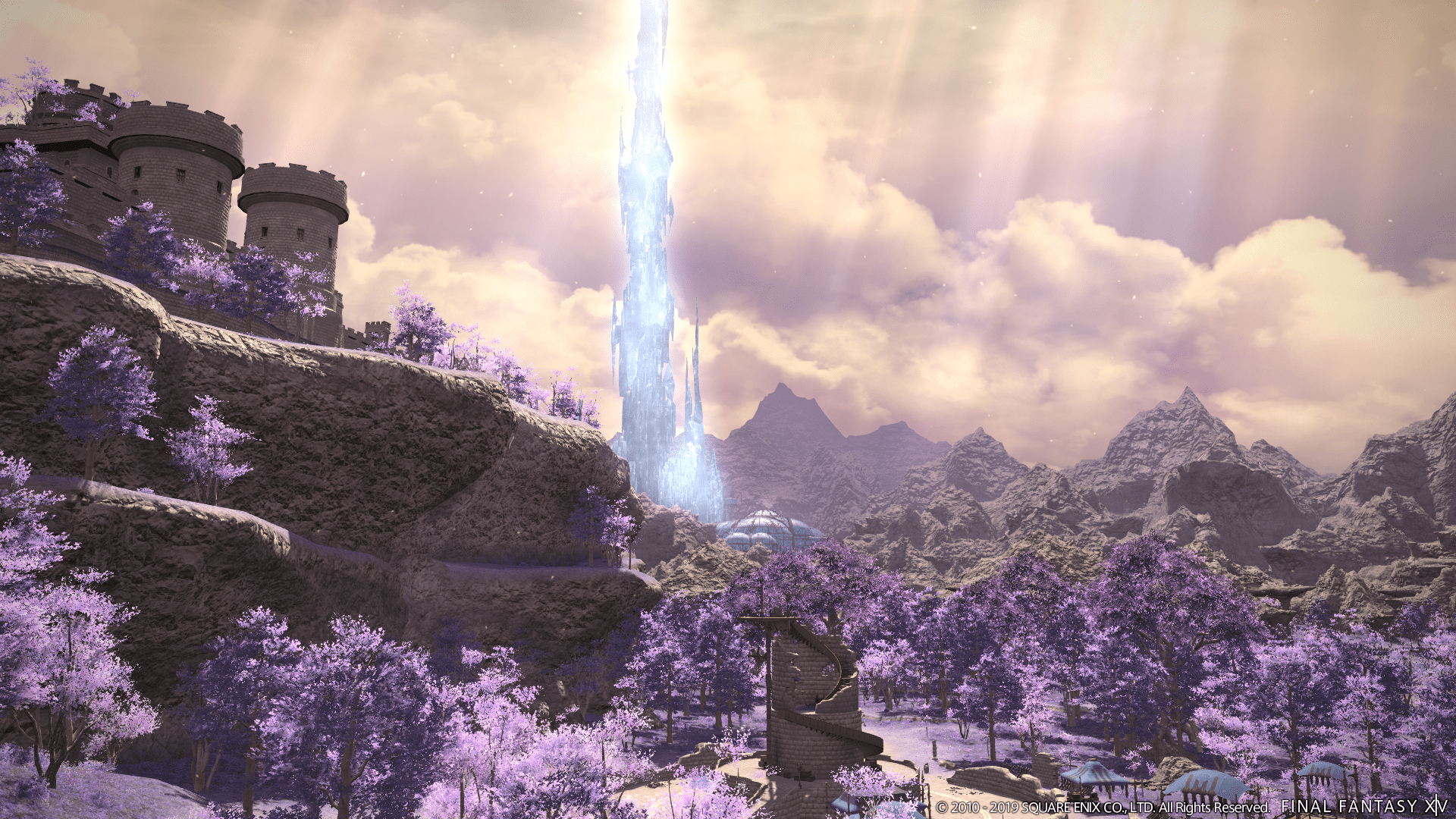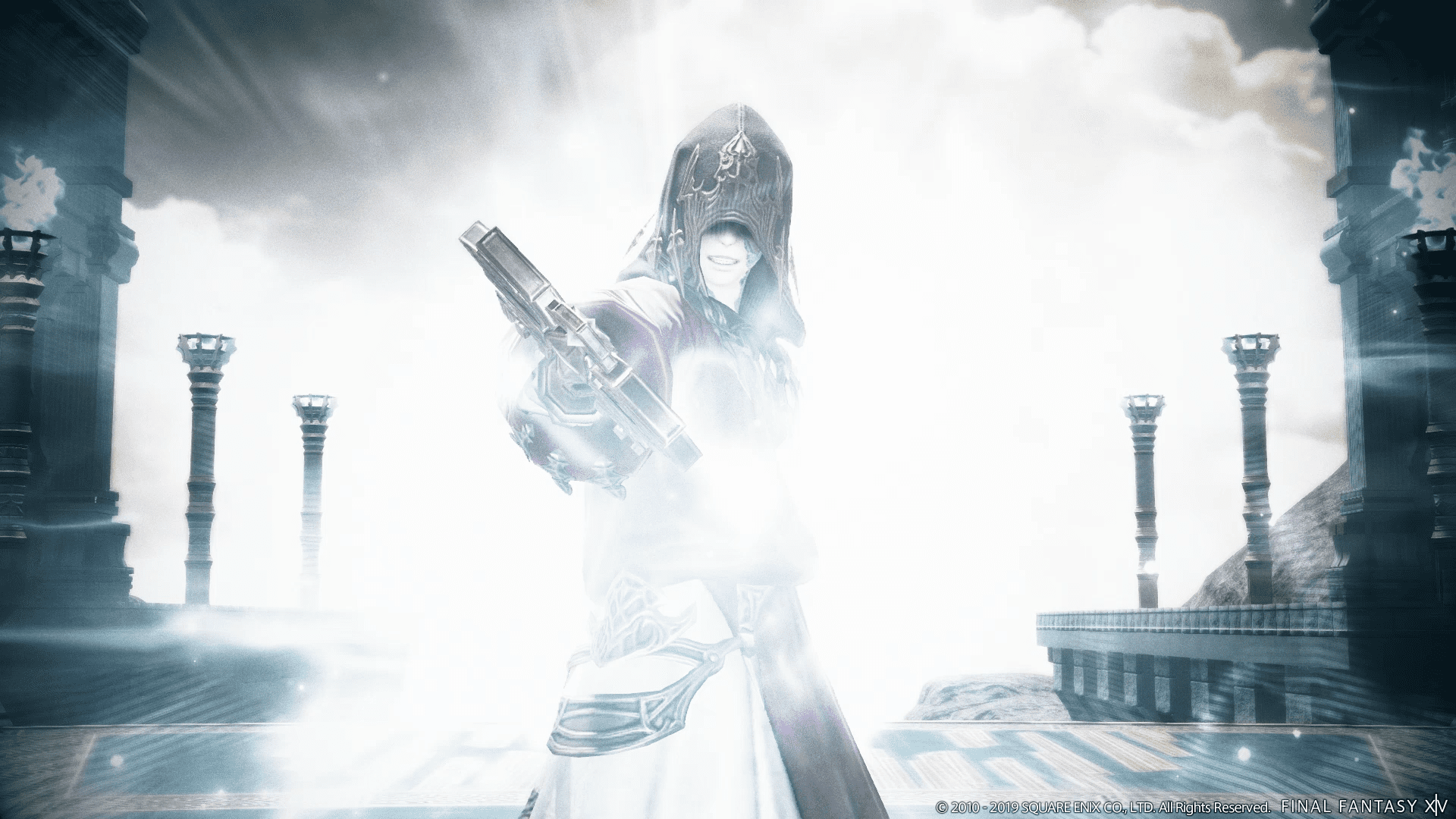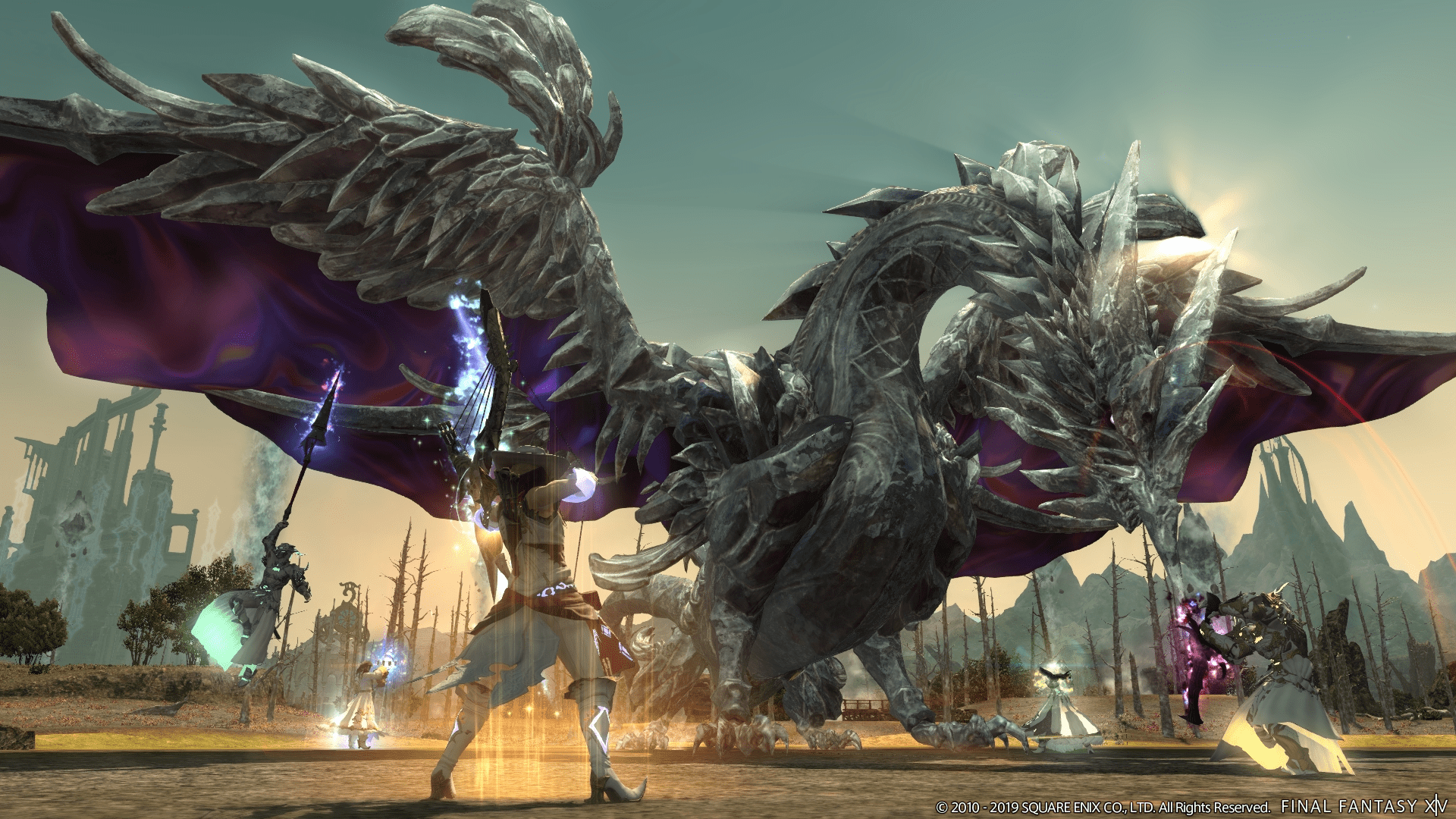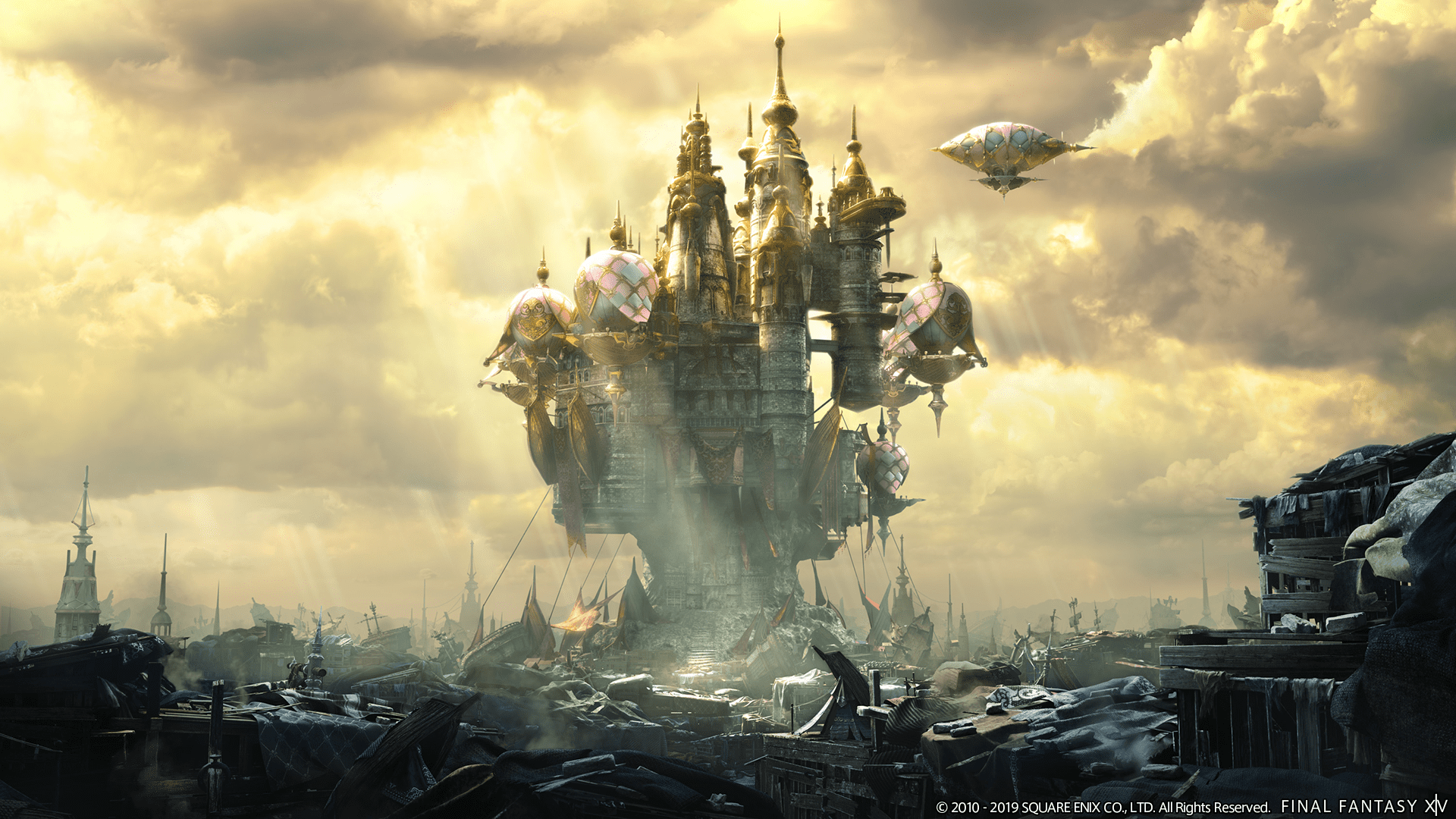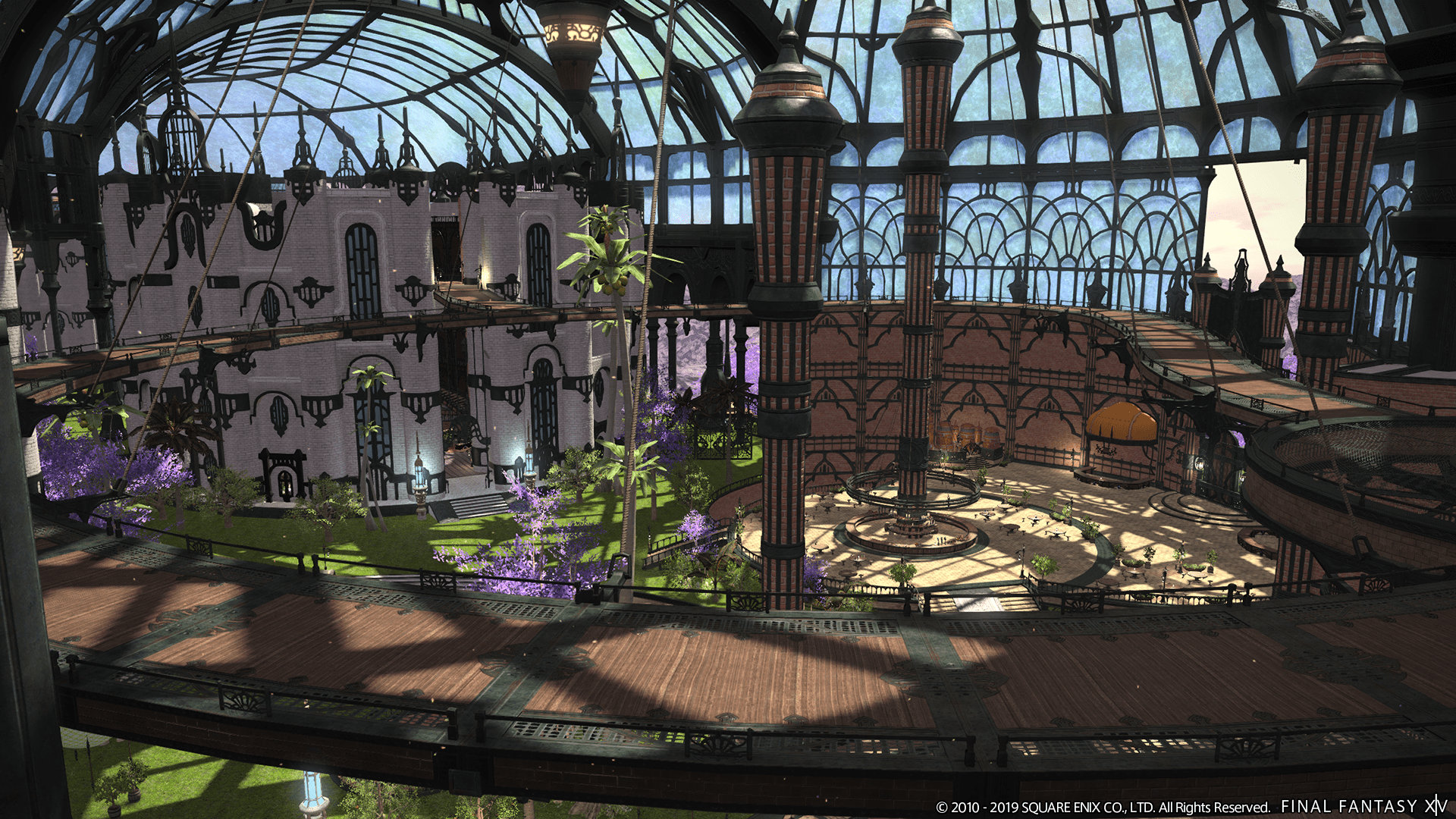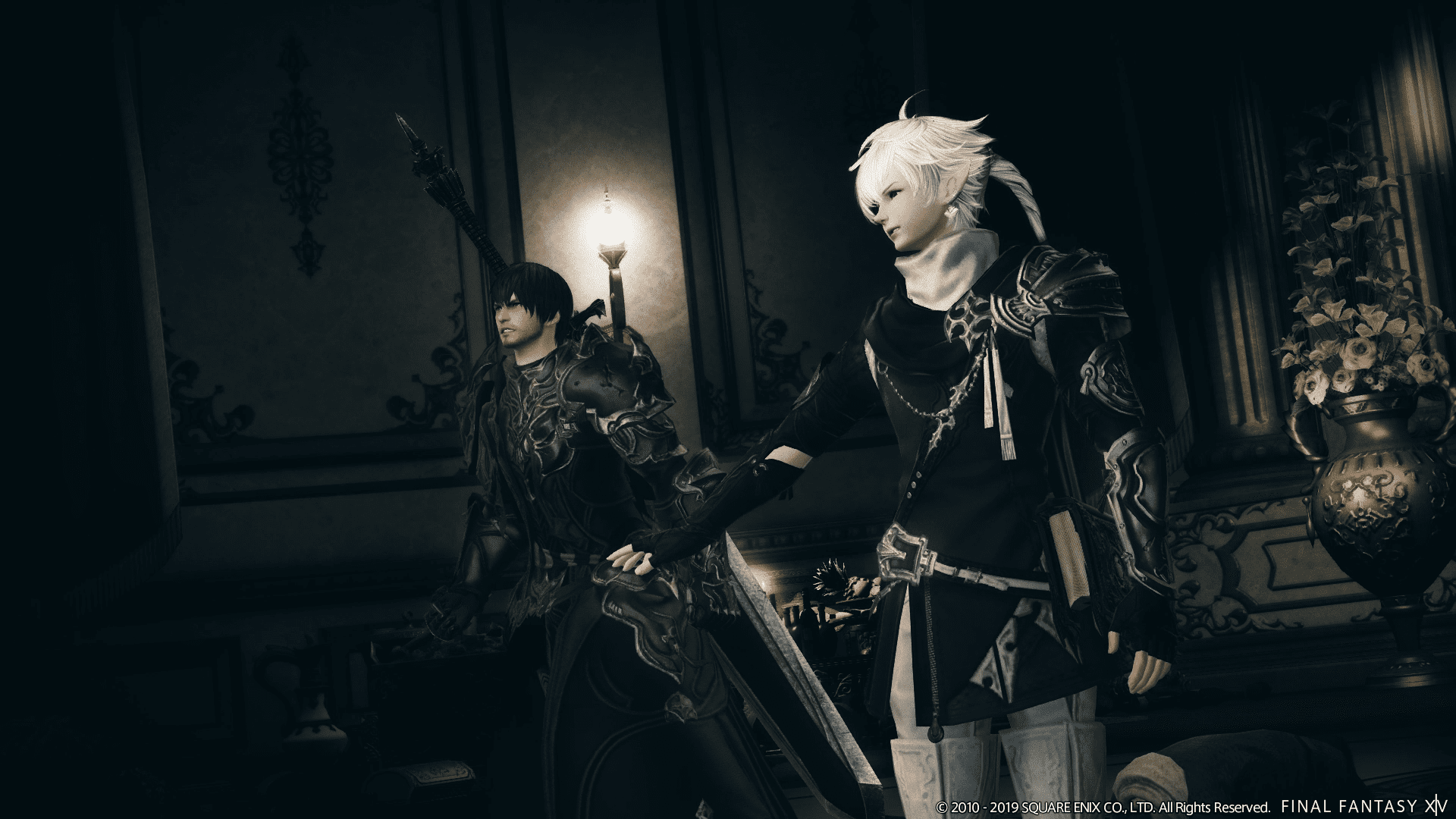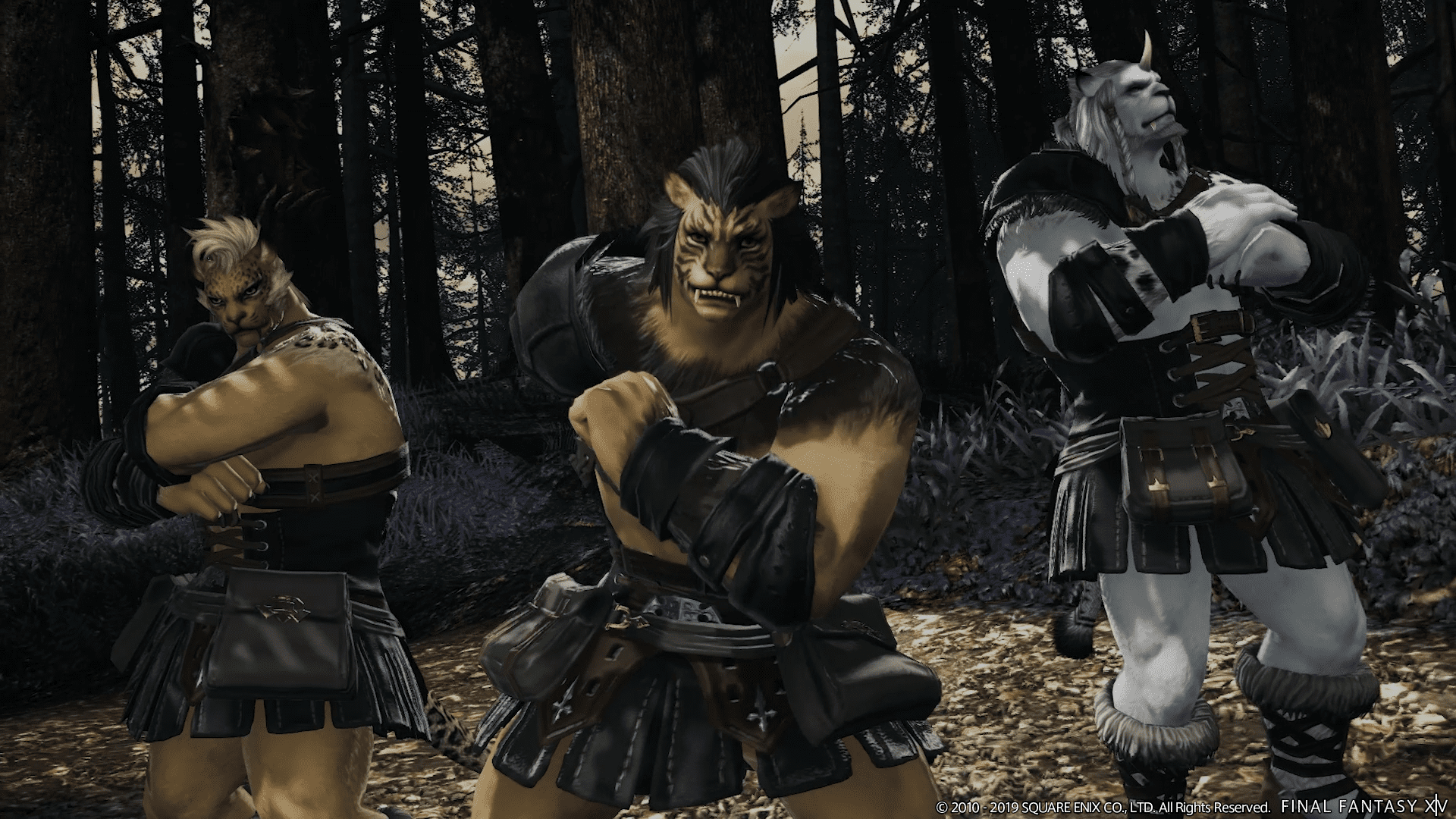Auf der diesjährigen Gamescom durfte ich ein äußerst interessantes Interview mit Final Fantasy XIV Producer Nakoi Yoshida und Main Scenario Writer Banri Oda führen, in dem wir über die kürzlich erschienene Erweiterung Shadowbringers, den kreativen Prozess hinter FFXIV allgemein und mehr sprachen.
(Das Interview wurde mittels Übersetzerin in Englisch abgehalten. Das originale Transkript findet ihr unter der deutschen Übersetzung)
Zunächst einmal vielen Dank, dass Sie sich heute die Zeit nehmen, mit uns zu sprechen. Shadowbringers ist nun seit ca. einem Monat auf dem Markt und ich denke, es war wohl eine nette Überraschung, zu sehen, wie positiv das Spiel von den Fans angenommen wurde. Wie fühlen Sie sich nun, da es draußen ist? Hat es Ihre Erwartungen erfüllt oder vielleicht sogar übertroffen?
Yoshida-san: Das gilt natürlich nicht nur für Shadowbringers, sondern für alle Erweiterungen, an denen wir arbeiten, aber wir versuchen immer, mit Herz und Seele bei der Sache zu sein. Insofern haben wir bei Shadowbringers nichts Besonders gemacht. Wir haben einfach genau das getan, was wir immer tun. Dennoch: Wir hätten nicht damit gerechnet, dass das Spiel so ein phänomenaler Erfolg wird, noch damit, dass wir so extrem positives Feedback von Fans aus aller Welt bekommen würden. Das war tatsächlich mehr, als wir erwartet hätten, und wir sind extrem glücklich darüber.
Oda-san: Das kreative Team ist wirklich glücklich darüber, wie gut das Spiel bei den Fans ankommt. Alle Team-Mitglieder spielen auch selbst mit ihren privaten Accounts und sehen, dass die Spieler Shadowbringers wirklich lieben. Die Chats sind voll mit Kommentaren und es ist großartig zu sehen, dass die Fans auch wirklich miteinander spielen. Wir sind wirklich dankbar dafür.
Die Story von Shadowbringers basiert auf einer recht alten Questreihe, der Kristallturm-Questreihe. Was hat Sie dazu motiviert, für die Story der Erweiterung wieder auf diese zurückzugreifen?
Oda-san: Da Shadowbringers in der First spielt und unsere Charaktere aus der Source stammen, gibt es im Grunde niemanden, der unsere Welt kennt – abgesehen von Ardbert, den wir bereits getroffen hatten, und Minfilia, die ebenfalls zur First gereist ist. Abseits dieser beiden gibt es aber niemanden, zu dem wir eine starke Bindung hätten; um die Story erzählen zu können, brauchten wir also zumindest noch eine weiter Person, die als eine Art Brücke zwischen den Welten dienen und diese verbinden konnte. Die Entscheidung, hierfür G‘raha zu nutzen, kam von Ishikawa-san, die auch zum Main Scenario Team gehört.
Yoshida-san: Die Ideen G’raha bzw. den Kristallturm zu nutzen kamen fast zur gleichen Zeit. Da wir einen Weg finden mussten, durch den Rift zu reisen, kam uns der Gedanke, dass der Kristallturm sich perfekt dazu anbot, dies zu bewerkstelligen. Gleichzeitig benötigten wir aber auch jemanden, der ihn kontrollieren konnte, und dafür kam eigentlich nur G’raha in Frage. Also brachten wir sowohl ihn wie auch den Turm in die Shadowbringers Story.
Oda-san: Außerdem ist es eines der Hauptthemen in Shadowbringers, an seinen eigenen Willen, seine Gefühle, Meinungen und Ansichten zu glauben und diese an unterschiedliche Leute weiterzugeben und G’raha vereint all diese Elemente in gewisser Weise. Insofern dachten wir, dass er generell gut in die Geschichte passt.
Ich denke, es ist sehr Final Fantasy, etwas aus der Vergangenheit zu nehmen und es in einer neuen Story wiederzuverwenden.
Yoshida-san: Vielen Dank. Im Endeffekt ist es so, dass das gesamte Entwicklerteam aus Fans der Reihe besteht, von Titeln wie FFIV, V und VI, die sie gespielt haben, als sie Kinder waren und zu denen sie deshalb eine starke emotionale Bindung haben. Ich denke, genau deshalb möchten sie auch Spiele entwickeln, die in gewisser Weise in Verbindung mit diesen älteren FF-Titeln stehen. Was Sie also gerade darüber gesagt haben, dass das Spiel in gewisser Hinsicht wie die früheren FFs ist, ist ein großes Kompliment, und wir freuen uns, das zu hören.
Gehen Sie manchmal zurück und spielen die alten Titel, um sich Inspiration zu holen, oder einfach, um wieder in die richtige Stimmung zu kommen?
Yoshida-san: Ich nicht. *lacht*
Oda-san: Ich schon manchmal.
Yoshida-san: Der Grund, warum ich die alten Spiele nicht mehr wirklich spiele ist jener, dass meine Rolle im Entwicklungsteam eine ganz andere ist als Oda-sans. Oda-san im Speziellen ist verantwortlich dafür, das eigentliche Herz und die eigentliche Seele von Final Fantasy XIV zu schaffen, also versucht er natürlich auch, die Essenz der vorigen Teile zurückzubringen. Er muss das Vermächtnis der Reihe in allen Aspekten verstehen, weil die Welt sonst nicht mehr wirklich funktionieren würde und die Spieler merken würden, dass damit etwas nicht ganz stimmt. Deshalb muss er immer wieder viel Recherche betreiben, um sicherzustellen, dass alles ist, wie es sein soll.
Außerdem: Auch wenn FFXIV aus dem Vermächtnis der älteren Titel heraus entstanden ist, versucht es nicht, diese zu kopieren. Insofern muss Oda-san natürlich die alten Titel immer wieder zu Rate ziehen, um alle Referenzen im Kopf zu haben, aber was mich anbelangt, ich habe ganz spezielle Erinnerungen an die Spiele von damals, als ich sie als Kind selbst gespielt habe, und ich würde diese lieber so belassen, wie sie sind. Wenn ich die Spiele jetzt, als Erwachsener, noch mal spielen würde, dann würden sie sich vermutlich anders anfühlen, und ich denke, es ist gut, auch jemanden zu haben, der die Titel aus einer anderen Perspektive sieht.
Es gibt mehrere Leute, die am Szenario arbeiten. Wie wird das innerhalb des Teams gehandhabt? Wie schaut der Ablauf aus, wenn es darum geht, die Story für neue Erweiterungen zu schreiben?
Oda-san: Was die Struktur des Szenario-Teams betrifft, gibt es zehn Schreiber, wobei jeder von ihnen für eine bestimmte Art von Quest zuständig ist. Eine dieser Quest-Arten ist natürlich das Hauptszenario, das von den Hauptszenario-Schreibern und Yoshida-san selbst geschrieben wird, und wir haben üblicherweise sehr intensive Sessions, in denen wir darüber sprechen, was in der Story als nächstes passieren soll.
Dann gibt es die Job- und Rollen-Quests, die bestimmten Leuten zugeteilt werden. Diese denken sich dann etwas aus und ich reviewe es, bevor alles zu Yoshida-san geht, damit er es absegnen kann.
Und dann wären da natürlich noch die Side Quests in jeder Region. Diese werden in viel engerer Zusammenarbeit mit den eigentlichen Game-Designern entwickelt, die diese dann ins Spiel integrieren müssen. Das Team entscheidet hier, wie viele Quests in jeder Siedlung etc. notwendig sind und welche Art von Gameplay diese haben sollen. Als erstes werden also diese Dinge festgelegt, und dann gibt es ein Meeting des Szenario-Teams, in dem wir darüber diskutieren, wie genau wir alles umsetzen.
Yoshida-san: Insgesamt dürfen bloß vier Personen am Hauptszenario arbeiten, da es, klarerweise, sehr wichtig ist. Eine davon ist Oda-san, eine weitere Ishikawa-san, und dann sind da noch zwei etwas jüngere Szenario-Schreiber, die sich stetig verbessern, und die im Moment an der Story für die Patches arbeiten. Es braucht ein gewisses Maß an Können, großartige Hauptszenarios zu schreiben, also ist die Zahl der Leute, die daran arbeiten können, natürlich begrenzt, und die Schreiber müssen sich das Recht, dies zu dürfen, erst verdienen.
Mein Kompliment in jedem Fall an das Side Quest Team. Meiner Meinung nach waren die Side Quests in Shadowbringers so gut in die Hauptstory integriert wie noch nie und es hat riesen Spaß gemacht, diese zu spielen.
Yoshida-san: Die Side Quests wurden tatsächlich alle von Oda-san gereviewed. Wir hatten da ein paar Episoden, die wir in der Hauptstory nicht mehr untergebracht, aber dann als Side Quests dennoch veröffentlicht haben. Deshalb war die Verbindung diesmal so stark. Aus diesem Grund war es uns auch möglich, dafür zu sorgen, dass das Side Quest Team und das Mainszenario-Team samt Oda-san so eng zusammenarbeiten konnten, um großartige Inhalte zu liefern.
Oda-san: Da wir das Universum der First in Shadowbringers das erste Mal gesehen haben und es demnach sehr viel gab, dass die Spieler lernen und aufnehmen mussten, wollen wir sicherstellen, dass die Haupt- und Nebenquests eng miteinander verbunden waren, sodass der Übergang in die neue Welt und ihre Geschichte reibungslos funktioniert. Insofern vielen Dank für das Kompliment.
Gibt es irgendeinen Haupt- oder Nebenquest, der nicht ganz so geworden ist, wie Sie das gerne gehabt hätten?
Oda-san: Ah, ja, die Job Quests. Wir mussten uns auf diese festlegen, bevor wir irgendwelche Informationen über die First hatten, also mussten wir sehr kreativ werden, um etwas zu schaffen, dass in die neue Welt passen würde – eine Welt, die noch gar nicht existierte. Das war hart. Ich kann jetzt zwar nicht wirklich etwas daran ändern, aber ich wünschte, es gäbe eine Möglichkeit, diese Quests mehr mit der First zu verbinden.
Yoshida-san: Was den Entwicklungsprozess betrifft, können wir Dinge nicht wirklich ändern – verschiedene Elemente, wie die Story und das Gameplay, müssen zeitgleich entwickelt werden und schreiten unterschiedlich schnell voran. Wir versuchen aber dennoch immer, alles so weit wie möglich zu verbinden und alle Bereiche als gleich wichtig zu betrachten.
Mit Shadowbringers wurde eine ganze Reihe neuer Dinge eingeführt: neue Rassen, neue Jobs, eine neue Welt mit neuer Geschichte. Wie läuft das ab, wenn Sie so etwas entwickeln? Schreiben Sie zuerst die Story und überlegen dann, welche Gameplay-Elemente am besten hineinpassen würden, oder legen Sie fest, welche Gameplay-Elemente neu hinzukommen sollen und schreiben die Story dann um diese herum, …?
Yoshida-san: Mein persönliches Ziel bei Final Fantasy XIV ist es, die bestmögliche Spielerfahrung zu schaffen, und all diese Dinge gehören da mit dazu. Was ich also üblicherweise mache, ist, dass ich ein allgemeines Design-Dokument anlege, in denen ich kurz alle wichtigen Elemente erfasse: die Hauptstory, neue Rassen, neue Jobs, neue Orte, neue Dungeons, etc. Danach gebe ich das Dokument dann an die Teams weiter, damit sie auf dieser Info aufbauen können. Natürlich bin ich aber auch bei Brainstorming-Sessions und Meetings dabei. Die Hauptstory entsteht beispielsweise für gewöhnlich in einer drei Tage langen Session, in der wir uns den gesamten Plot für die neue Erweiterung überlegen, und so ähnlich läuft das auch bei allen anderen Elementen. Es ist immer das jeweilige Team und ich.
Eine Frage noch, zum Trust-System: Ich denke, das System war eine großartige Idee, aber gibt es auch Pläne, es zu erweitern, sodass beispielsweise auch drei Freunde gemeinsam mit einem NPCs spielen können?
Yoshida-san: *lacht*. Im Moment ist das Trust-System so eingestellt, dass man mit drei NPCs in den Kampf zieht, die das eigene Verhalten beobachten, einen umgeben und dann so reagieren, wie das für den jeweiligen Spieler am nützlichsten ist. Würden wir mehr menschliche Spieler zur Party hinzufügen, müsste das System entsprechend komplexer werden, um das Spielerverhalten analysieren und darauf reagieren zu können. Wenn wir so etwas also möglich machen wollten, müssten wir einige Dinge anpassen und die NPCs könnten dabei an Effektivität verlieren. Wir möchten die Qualität des Systems allerdings so hoch wie möglich halten.
Hinzu kommt, dass bei mehr Spielern in Kombination mit unseren aktuellen 17 Jobklassen, die Anzahl der möglichen Job-Kombinationen stark ansteigen würde und wir müssten all diese Kombinationen noch dazu für jeden einzelnen Dungeon berücksichtigen. Und natürlich müssten wir auch jede Kombination manuell überprüfen, um sicher zu gehen, dass auch alles so funktioniert, wie es soll. Der Arbeitsaufwand und die Debug-Kosten wären enorm, und die Einführung dieser Änderungen könnte überdies die Veröffentlichung weitere Erweiterungen verzögern. Alles nicht so einfach. Aus diesem Grund gibt es aktuell leider keine Pläne, das System mehr menschlichen Spielern zugänglich zu machen.
Englische Originalversion
First of all, thank you very much for taking the time to speak with us today. Shadowbringers has been out for about a month now and I think it must have been a nice surprise to see how well-received it was by the fans. How do you feel now that it’s out and new things are on the horizon? Did it meet or even exceed your expectations?
Yoshida-san: This is not just the case for Shadowbringers but for any expansion we’ve released in the past, but we always try to pour all our heart into it, so we didn’t really do anything special for Shadowbringers this time. We just kept on doing the same thing that we’ve done so far. Having said that, we did not expect the game to be such a phenomenal success, nor that we would receive such extremely positive feedback from fans all around the world. That was indeed more than we expected, so we are extremely happy about the results.
Oda-san: The creative team is very happy about how well the game was received by the players. They all play the game on their personal accounts, too, and when they do, they see that the players really love Shadowbringers. The chat windows are full of comments and it’s great to see that the fans actually play the game together. We are really grateful for that.
Shadowbringers’ story is based on a rather old side quest, the Crystal Tower side quest – what inspired you to build on that story line for this expansion?
Oda-san: Because Shadowbringers takes place in the First and we are people from the Source, there is not really anyone there who knows our world except for Ardbert, who we’ve met before, and also Minfilia, who has also travelled to the First. But apart from those two people there isn’t really anyone there we have a strong connection to, so, from a storytelling point of view, we needed at least one other person who could breach the gap between the worlds and connect them. The decision to use G’raha for this came from Ishikawa-san, who is another one of our main scenario writers.
Yoshida-san: We had the idea to use the Crystal Tower and G’raha almost at the same time. Since we needed to find a way to travel through the rift, we thought the Crystal Tower could be used as a means for that, but then it needed someone who could somehow control it and G’raha was the only person who could really do that. So we brought both him and the tower into the Shadowbringers story.
Oda-san: Also, one of the major themes in Shadowbringers is to trust in your will, emotions, opinions and views and to pass them down to different people, and G’raha is kind of the culmination of all that, so we thought that he naturally fit into the storyline.
I think it’s a very Final Fantasy thing to do, to take something that came up in the past and use it again in a fresh story.
Yoshida-san: Thank you. You know, at the end of the day the members of the development team are all fans of the series, of legacy titles like FFIV and V and VI, which were the ones they played when they were children, so they have strong memories of and feelings for these titles. I think it is for this reason that they also try to develop games that in some way connect to these older FF titles. So, what you just said about the game, in a way, being like older FFs is a huge compliment and we’re really happy to hear that.
Do you sometimes replay the old FF games to get inspiration or just to get into the feeling again?
Yoshida-san: I don’t. *laughs*
Oda-san: I do sometimes.
Yoshida-san: The reason I don’t really is because my role within the development team is different from Oda-san’s. Oda-san, especially, is responsible for creating the very heart and soul of Final Fantasy XIV, so he’s also trying to bring back the essence of previous titles. He needs to understand the legacy that is Final Fantasy in every detail, otherwise it’s gonna break the world and players will notice that things aren’t quite right. So he really needs to research everything over and over again to make sure everything is and feels as it should.
What’s more, even though FFXIV was born from the legacy of the older titles, it is not trying to copy those games. So, of course Oda-san needs to go back to the old titles sometimes to remember all references, but as far as I’m concerned, I have this specific memory of when I played those games when I was a child and I’d rather keep them as they are. If I played them again now, as an adult, they would probably feel different and I think it’s good to have someone who looks back on those games from a different perspective, too.
There are several people working on the scenario. How do you handle that during development? What’s the process behind coming up with new stories for the game?
Oda-san: Speaking of the structure of the scenario team, there are actually ten scenario writers and each of them is responsible for a specific type of quest. One of those types is of course the main scenario which would be written by the main scenario writers and Yoshida-san himself, and we usually have very intense sessions where we talk about what should happen next in the story.
Then there are the job and role quests, which will be assigned to specific people. They will come up with those and then I will review them before presenting them to Yoshida-san for final approval.
And, of course, there are also the side quests for each area. Those are developed in much closer cooperation with the actual game designers who will implement those quests. They will decide how many quests are required for each settlement etc. or what kind of gameplay they should feature. So first they will decide on these things and then there will be a meeting of the scenario team where they will discuss how exactly to go about those quests.
Yoshida-san: As regards the structure of the scenario team, there are only four people that may actually work on the main scenario since it is, of course, really important. One of them is Oda-san, another is Ishikawa-san, and then there are two somewhat younger scenario writers who are growing and improving as writers, and they are currently working on the patch scenarios. It requires quite some skill to write great main scenario quests so of course the number of people who can work on them is limited and the writers have to earn the right to do so.
Please forward my compliments to the side quest team. I thought that the side quests in Shadowbringers tied into the main story better than ever and it was great playing them.
Yoshida-san: Actually, all those side quests where reviewed by Oda-san. There were a few episodes that we had come up with that could not be told within the main scenario, but we used side quests to tell the additional story. That’s why the link was so strong. Because of this we were also able to establish that the side quest writers and the main scenarios writers like Oda-san would work really closely together to create great story content.
Oda-san: Because the universe of the First is something that we see for the first time in Shadowbringers and there is a huge amount of information for the player to take in as regards the world and its people, we wanted to make sure that the main and side quests were closely connected, so that the transition to the new world and lore would be smoother. So, thank you very much for that compliment.
Is there any main or side quest where you feel it didn’t quite turn out the way you would have liked?
Oda-san: Ah, yes, the job quests. We had to decide on those before we really had any information about the First, so we had to really use our imagination to create something that would fit into that new world, into something that was not there, yet. That was quite tough. It’s not like I can really do anything about it now, but I wish there was a way to link them to the First a bit more.
Yoshida-san: When it comes to the development process, there isn’t much we can do about those things – different elements, such as the story and gameplay, have to be developed at the same time, and they progress at different speeds. But we will still try to connect them as much as possible and to treat them as equally important.
So, for Shadowbringers you introduced a lot of new things: new races, new jobs, a new world with new lore. What’s the process when you create those things? Do you first come up with the new story and then decide what would fit gameplay-wise or do you take a look at what you want to introduce gameplay-wise and then fit the story around that, …?
Yoshida-san: My personal goal with Final Fantasy XIV is to create the best possible game experience and all those things are a part of that. So, what I usually do is create a general game design document with very basic info on all major elements: the main scenario, new races, new jobs, new locations, new dungeons, etc. Then I will give that document to the teams so they can build on that info. So, in the end, I come up with the rough structure and the different teams will work on the details. Of course, I will join them for brainstorming sessions and meetings, though. For the main scenario, for example, we usually have a three day long session where we come up with the plot for the new expansion, and it’s almost the same for the other elements. It’s always the respective team and myself.
One more question, about the trust system: I think it was a great addition to the game but I’m wondering, do you plan on expanding on it so that, let’s say, three friends could also play with one additional NPC?
Yoshida-san: *laughs* Right now the Trust system is set up so that when you choose to use it, the three NPCs will pay attention to the player, surround him and react in a way that will be as useful to them as possible. If we added more human players to the party, the system would have to be more complex in order for it to correctly analyze player behaviour and react to it. So, if we did that, we would need to make quite a few adjustments and the NPCs might also turn out to be less effective. However, we would like to keep the quality as high as possible.
What’s more is that with 17 jobs, if we allowed for more human players in the party, the number of possible job combinations would become much higher than it is now and we would need to consider all of those for each dungeon, and check each possible combination manually to see if it works how it is supposed to. The workload and debug costs would be enormous, so implementing those changes could delay the release of future expansions. It’s tricky. So, unfortunately, at the moment we don’t have any plans to open the Trust system up to more human players.

